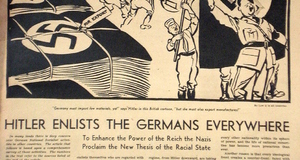From Elon Journal of Undergraduate Research in Communications VOL. 5 NO. 2From "Pockets of Poverty" to Potential Prosperity in Appalachia: Examining Mass Media Narratives of Poverty Stereotypes in Appalachia
IN THIS ARTICLE
KEYWORDS
AbstractThis research examined poverty stereotypes in Appalachia that were portrayed in a national newspaper, The New York Times, and a local newspaper, The Mountain Eagle in Whitesburg, Kentucky. The study looks at framing through narrative and content analysis for January 2014, the period in which the media revisited the 50th anniversary of the War on Poverty. The research also compared these findings with the coverage of these papers in January 1964, when Lyndon Johnson declared the War on Poverty in Eastern Kentucky. The research found national media primarily focused on economic issues and used more negative language in 1964, in comparison with the local newspaper. The study found that the two newspapers switched their coverage pattern 50 years later. IntroductionThree years ago, the researcher drove through green hills into the town of Whitesburg, Kentucky, population 2,078 (2012 census), although the old Royal Crown Cola-sponsored welcome sign will tell you, “1,534 friendly people plus 2 grouches.” Inside Appalshop, a local media, arts, and education center, a man sat cross-legged on a simple wooden stage. Introducing himself as Derek Mullins, he told the story that inspired this research: “I never knew I was poor until outsiders came in and told me I was poor; it was only then that I became ashamed of my roots and identity.” This version of self-othering—of not only allowing external definitions to isolate a particular group, but also influencing a sort of internal exploitation by the groups themselves—can affect how these levels of truths can blur the lines between who holds and produces knowledge. This research asks, who has the power to tell the stories of communities, and what are the responsibilities of the storyteller? How have regions such as Appalachia been misrepresented by the circulation of stereotypes in visual culture? General public discourse suggests Appalachian people are often trapped in an ideological construct of a hillbilly stereotype in American culture. This research examines media narratives of poverty stereotypes in Eastern Kentucky and asks, how do local media frame issues of poverty in Appalachia compared to national media? The research compares the framing of the media coverage through narrative analysis and content analysis of a national newspaper, The New York Times, and a local Appalachian newspaper, The Mountain Eagle, in Whitesburg, Kentucky for January 2014, the period in which the media revisited the 50th anniversary of the War on Poverty. For comparison, the research also analyzes the framing of the media coverage for January 1964, the month Lyndon Johnson declared the War on Poverty in Eastern Kentucky. This research asks, how do local media visualize and frame topics of poverty and the 50th anniversary of the War on Poverty in Eastern Kentucky compared to national media? The study examines the factors in national and local newspaper coverage that may influence poverty stereotypes of Appalachian people. Local media are more likely to use positive language and visuals than national media when reporting on the War on Poverty. In addition, national media are more likely to focus on the economics of poverty than local media, who are more likely to focus on social and cultural aspects of poverty. Literature ReviewThe 50th anniversary of the War on Poverty that was celebrated in January 2014 garnered much media attention and brought Appalachia’s economic standing into the national spotlight as did President Lyndon Johnson’s declaration on an “unconditional” War on Poverty on the footsteps of a home in Eastern Kentucky in January 1964. The anniversary prompted a wide-ranging debate on whether the war has succeeded or failed, or is even ongoing. The Heritage Foundation’s Robert Rector called it a “catastrophe,” while the White House claimed the war “lived up to our best hopes as a people who value the dignity and potential of every human being” (Matthews, 2014, p. 1). As scholars study the changing values of the U.S. official poverty line since its definition in the 1960s, there is renewed debate about whether Appalachia is still considered the face of poverty in America. Context on the War on Poverty and the Culture of PovertyWhen Johnson promised to “bring rural America into the mainstream of American prosperity” in 1964, it also meant drawing Appalachia into the mainstream of American media (Bowler, 1985, p. 239). According to March (1966), “The ‘war on poverty’ is a landmark in the focusing of public concern on the broad range of social problems and programs which affect people, and in developing new and more effective approaches for concerting resources and action to strike at the root causes of poverty” (p. 115). Prior to the War on Poverty, there was little media attention about poverty in America; in fact, there was not a poverty heading in the index of The New York Times until the declaration (Bowler, 1985). Furthermore, the War on Poverty led to the construction of Oscar Lewis’ concept of the culture of poverty, which explains the persistence of poverty in terms of presumed negative qualities within a culture: family disorganization, group disintegration, personal disorganization, resignation, and fatalism (Harvey & Reed, 1996). Appalachia has been used as a prime example of the systematic construct of the culture of poverty, facing lingering images of poverty-stricken “hillbillies” (Bowler, 1985; Price et al., 2000; Sarnoff, 2003). Consequently, an outside-inside dichotomy emerged, and the idea of blaming mountain people and viewing them as separate from the rest of American culture predominated in popular media culture. For instance, in a Fox News program on February 13, 2009, conservative commentator Bill O’Reilly criticized the “culture of poverty” and “culture of ignorance” in Appalachia by saying that Appalachian culture harmed children because of alcoholic parents and the widespread drug influences among other “irresponsibility” (Cooper, Knotts & Livingston, 2010, p. 26). Appalachian Stereotypes in MediaIn a 1976 Appalachian case study, Seltzer noted that among minority groups commonly excluded from journalist news networks, such as women, racial minorities, ethnic groups, low-income people, and groups challenging powerful interests, “hillbillies” received the worst media treatment (Speer, 1993). Academics have observed that while most Appalachians do not want to separate themselves from their regional link because of geographical identifiers, they are often superficially and externally assigned to stereotyped limitations of the region through media characterizations of Appalachians in American visual culture. It is only when these stereotypes are discarded that Appalachians feel authentically Appalachian (Snyder, 1982; Massey, 2007; Ferrence, 2012). Maggard (1983-84) observes two general frames that characterize images of Appalachia in the national media: (1) Misleading reporting and a lack of in-depth analysis dominate media, and (2) Reporters often fail to grasp the historical context, the economic context, and the motives of key actors on opposing sides. Because of their limited contact with the region, national journalists often overlook the mountain middle class and rich. Instead they search for images that fit their preconceived notions about rural poverty (Bowler, 1985; Ferrence, 2012). In the same sense, former Congressman William C. Cramer from Florida said, “By selecting certain pockets of poverty and eliminating other parts of the country, [federal aid to Appalachia] can be used in a discriminatory manner for political expediency, executive favoritism, and vote buying on a grand scale” (in Bowler, 1985, p. 246). These portrayals create gross generalizations of Appalachia in which selected images by mass media do not represent the whole. Some of the most popular media images of Appalachian people include people living without electricity or children without shoes. Other general representations of Appalachian differences often refer to physical traits that signify “otherness,” including illnesses, deformities, ragged clothing, unkempt appearances, poor dental hygiene, and prematurely aged men and women with sluggish postures and blank stares (Sarnoff, 2003; Scott, 2009). In The New York Times, the Consultant to the President’s Appalachian Regional Commission, Benjamin Chinitz, wrote, “The immigrants from Appalachia do not assimilate very readily to modern urban industrial society in northern metropolitan areas” (Chinitz, 1964, p. A1). While images of desolation can attract public interest and catalyze actions to tackle poverty, they can also reaffirm the marginalization that allows the exploitation of marginalized communities (Snynder, 1982; Scott, 2009). In a television review in The New York Times, journalist Jack Gould wrote about CBS’s Charles Kuralt, who showed an Appalachian Christmas segment juxtaposing the celebration of Christmas in other parts of America with an abandoned coal mining community in Eastern Kentucky: The camera showed the worn faces and discouragement in the eyes of the adults, the children who have scant prospects of gaining any education, the broken remnants of buildings that serve as homes and the cold and dirt of the ever-gray surroundings. (Gould, 1964, p. A1) Scholars have linked images and individuals’ perceptions of them directly to the construction of internal identities and senses of self (Snyder, 1982; Lacan 2004; Massey, 2007). When scholars consider how images contribute to the definitions, relations, and perceptions of how people connect to their environment and interpret the lessons of an image, they ask the crucial questions: What can a disempowered people do if they do not want their pictures taken? What does it do to people when they are made the objects of the nation’s pity? (Wang, 1999; Price et al., 2000). Main GoalsThe purpose of this research is to examine how media narratives of poverty stereotypes from the 1960s can affect Appalachian people today through emic and etic perspectives. An emic approach includes accounts expressed by the research participants or the native members of the culture being studied, and an etic approach includes accounts expressed by scientific observers who apply existing theories and cultural frameworks to the setting (Lett, 1990). The research compares the framing of the two newspapers through narrative analysis and content analysis for January 2014, the period in which many media organizationsrevisited the 50th anniversary of the War on Poverty. The study then connects research on the framing of the media coverage through media analysis for January 1964, the month Lyndon Johnson declared the War on Poverty in Eastern Kentucky. MethodsThe research employs quantitative and qualitative research methods, including a content analysis to compare local and national media coverage during January 1964 and January 2014. An underlying hypothesis is that local community members and media are more likely to use positive language and visuals than national media when reporting on the War on Poverty. In addition, national media are more likely to focus on the economics of poverty than local community members and media, who are more likely to focus on social and cultural aspects of poverty than on the economics of poverty. Framing theory suggests that the presentation of a topic, or the frame by which information is strategically organized to structure social meanings, influences the perception, beliefs, and ideas of the audience (Fairhurst & Sarr, 1996). Frames are used as an interpretive device to help people make sense of a topic by emphasizing specific features rather than trying to process all available information. Examples of framing techniques that are particularly relevant to this research include stories, or the framing of subjects through memorable anecdotes; and spin, or the discussion of an idea with a positive or negative connotation (Fairhurst & Sarr, 1996). Framing is a beneficial analysis tool because understanding the frames employed by particular organizations or groups distinguishes what they consider important, so researchers can achieve a better understanding of how and why people interpret situations and ideas. This research seeks to understand the ways different types of mass media focus on various issues in Appalachia, which will shed light on how the poverty stereotypes of Appalachia have developed, and more importantly, how these general perceptions affect the identity, discrimination, and marginalization of Appalachian people. Framing theory is helpful in studying media narratives because the media can influence public opinion by focusing on salient aspects of a news story. These frames help viewers decide who or what is responsible for the cause or solution of an issue, whether it can be looked at from broader social factors and institutional accountability or personal responsibility (Entman, 1993). This research focuses on thematic news frames, or frames that place public issues in a broader context by focusing on general conditions or outcomes (Inyengar, 1991). For example, the way a news organization might frame a person living in an impoverished community in Appalachia could affect whether the public sees the individual as “lazy” or as a victim of a larger, problematic societal system. While journalists generally attempt to follow fair and balanced reporting practices, there may still be a dominant framing of news that the media use to influence public opinion. Developed by scholars Max McCombs and Donald Shaw (1972) in a study of the 1968 presidential election to understand the degree to which the media determines public opinion, agenda-setting theory describes the ability of the news media to influence the salience of public agenda topics. Agenda setting theory suggests the media can not only reflect reality but also determine reality by presenting topics in a manner designed to attract the public and policy makers (Miller & Krosnick, 1996). Agenda setting theory focuses on the idea that the media does not tell the public what to think, but rather, what to think about. Consequently, the news media are primary agenda-setting agents because of their ability to set the agenda for how the public reacts and how policy makers respond through legislation (Entman, 1993; Miller & Krosnick, 1996). In this research, two news outlets are examined to compare the media coverage and framing of the coverage on Appalachian poverty stereotypes: a national outlet, The New York Times; and a local Appalachian newspaper, The Mountain Eagle in Whitesburg, Kentucky, near where Johnson launched the War on Poverty in January 1964. The research observes how each outlet portrayed people in Eastern Kentucky by analyzing articles and visuals from the media coverage and developing categories through emergent coding to identify themes associated with Appalachian people. The Mountain Eagle was selected as the local newspaper because it is based in Eastern Kentucky and was one of the only local newspapers in the area at the time to cover Johnson’s tour of Appalachia. The New York Times was selected as the national newspaper because it was one of the first newspapers to cover Johnson’s War on Poverty. The keywords “Johnson” and “Poverty” were used to search archives of The Mountain Eagle for January 1964, yielding 12 relevant articles; the keyword “Appalachia” was used to search the archives of The New York Times, during the same period, yielding 11 relevant articles. The month of January 1964 was selected because it is the month in which President Johnson officially declared the War on Poverty in his State of the Union address to the Congress. From there, he toured Appalachia to promote awareness of poverty, and emphasized Eastern Kentucky as an area in which poverty was particularly prevalent. After reading through the newspaper articles and recognizing patterns, I coded for tone and rhetoric, characteristics in reference to Appalachian people, functions, and visuals. This process was repeated, with a few additional categories developed through emergent coding, for the comparison between the two newspapers in their coverage of the 50th anniversary of the War on Poverty in January 2014, when Appalachia was once again brought into national media spotlight. Strauss and Corbin (1990) describe open coding as the “process of breaking down, examining, comparing, conceptualizing, and categorizing data” (p. 61). The coding sheet developed in this research followed a protocol by Creswell (1998) for recording information from data and identifying key categories related to the ideas and concepts based on the research questions. The content analyses were conducted according to the constant comparative method, or the process of comparing information from data collection to previously identified categories (Creswell, 1998). The coding sheets were based on an eight-step guide by Tesch (1990): (1) Read through all of the data carefully, recording ideas as they come to mind; (2) Pick one document and ask what the underlying meaning is, writing thoughts in the margin; (3) Make a list of all topics, or cluster similar topics, and form them into columns that might be grounded as major topics, unique topics, and leftovers; (4) Take this list and return to the data, abbreviating topics as codes and writing the codes next to corresponding segments in the data, trying out the preliminary organizing scheme to check for emerging categories/domains and codes; (5) Refine the organizing system; (6) Make a final decision on the abbreviations and alphabetize these codes; (7) Assemble the data material belonging to each category together and perform a preliminary analysis; and, (8) Recode the existing data if necessary.Continued on Next Page » Suggested Reading from Inquiries Journal
Inquiries Journal provides undergraduate and graduate students around the world a platform for the wide dissemination of academic work over a range of core disciplines. Representing the work of students from hundreds of institutions around the globe, Inquiries Journal's large database of academic articles is completely free. Learn more | Blog | Submit Latest in Business & Communications |

















